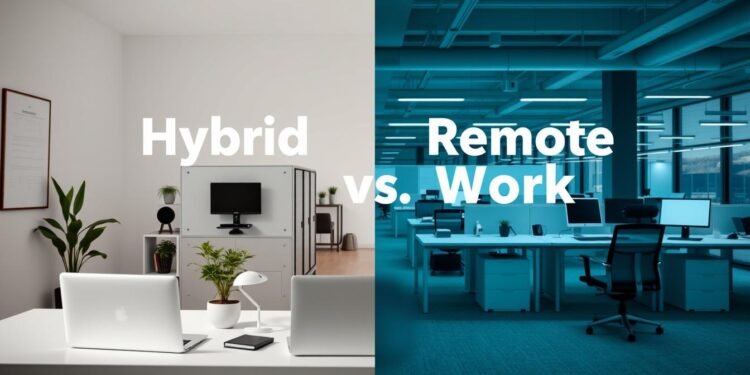Have you ever wondered which work model truly boosts productivity—flexible schedules or traditional office setups? The post-pandemic world has reshaped how employees and employers view workplace dynamics. Over half of the workforce now considers flexible arrangements, with 72% of companies adapting to this shift.
Recent data shows hybrid employees report higher engagement (36%) than those working fully remotely (32%) or onsite (27%). Yet, remote workers gain back 72 minutes daily by skipping commutes. With such trade-offs, choosing the right setup depends on balancing flexibility and collaboration needs.
This guide explores key trends like “flexible Fridays” and asynchronous communication. Whether you’re an employer or employee, understanding these models helps navigate modern work norms.
Key Takeaways
- 52% of employees now prefer flexible work options.
- Hybrid setups show 36% engagement, outperforming other models.
- Remote workers save over an hour daily on commutes.
- 72% of companies offer adaptable arrangements.
- Trends like asynchronous work are reshaping productivity.
Understanding Hybrid and Remote Work Models
Companies are redefining work structures to match employee and business needs. Two popular approaches—hybrid and remote models—offer distinct ways to balance productivity and collaboration. Let’s break down how each operates.
What Is Hybrid Work?
A hybrid model blends office and home-based days. Employees typically split time, like 2-3 days onsite. This setup maintains team connections while allowing focus time at home.
Hybrid models use 60% less office space than traditional setups. Some companies set fixed “anchor days” for meetings. Others let staff choose days based on tasks.
What Is Remote Work?
Remote work removes location limits. Teams rely on digital tools like video calls—83% use them daily. No physical office is needed, cutting overhead costs entirely.
This model taps into global talent pools. Unlike hybrid roles, remote jobs don’t require employees to live near an office. Time zones and async communication become key factors.
Hybrid vs Remote: Key Differences and Similarities
Work arrangements have evolved, creating distinct advantages in flexibility and collaboration. While both models break from traditional offices, their approaches to scheduling, teamwork, and hiring vary significantly.
Flexibility and Structure
Location-independent roles offer complete scheduling autonomy. Employees may design their day around peak productivity hours without office constraints.
Structured arrangements blend 2-3 office days with remote work, using hot desking systems in 67% of cases. This balances routine with personal focus time.
Team Collaboration Dynamics
In-person teams excel at spontaneous brainstorming. Hybrid models maintain this strength during office days while requiring less meeting time than fully distributed groups.
Remote teams invest 23% more hours in scheduled video calls. They compensate with async documentation tools for continuous progress tracking.
Geographical and Talent Considerations
Local hiring pools grow 41% with flexible office policies. Fully distributed companies access 300% more candidates globally, often achieving 37% cost savings.
Proximity bias in hybrid setups may affect promotion rates. Meanwhile, remote-first organizations build cloud-based systems rather than maintaining dual office/digital infrastructures.
Pros and Cons of Remote Work
The rise of location-independent jobs has transformed how companies and employees approach daily productivity. Fully remote models offer freedom but require adjustments to maintain efficiency and security.
Advantages of a Fully Remote Model
Businesses save an average of $11,000 annually per employee by eliminating office costs. Remote employees also report 54% higher productivity due to fewer distractions.
Flexible schedules improve work-life balance. Teams can hire globally, accessing diverse talent without relocation barriers.
Challenges of Remote Work
Cybersecurity risks spike by 238% in remote setups. Companies combat this with VPNs and hardware stipends.
Isolation affects 48% of remote workers. Structured virtual check-ins and coworking spaces help bridge the gap.
Despite efficiency gains, 22% of employees work longer hours remotely. Clear performance metrics prevent burnout.
Pros and Cons of Hybrid Work
Balancing office and home-based work brings unique advantages and challenges. Hybrid work arrangements let employees split time between locations, but success depends on execution.
Benefits of Hybrid Work Arrangements
78% of employees report better mentorship access when working partially onsite. Face-to-face interactions foster skill development and team cohesion.
Companies using hybrid models retain 65% more staff. Flexible schedules reduce burnout while maintaining office connections.
Decision-making speeds up by 29% during in-office days. Teams resolve complex issues faster with spontaneous discussions.
Drawbacks of Hybrid Models
Coordination costs rise by 31% in hybrid setups. Aligning schedules across locations requires extra effort.
Office spaces see just 43% desk occupancy on average. Companies adopt hub-and-spoke real estate strategies to cut waste.
Overlapping availability issues affect 57% of teams. Clear communication tools ensure equal participation in meetings.
Tech disparities may arise. Remote participants need equal access to discussions and resources.
How to Decide Between Hybrid and Remote Work
82% of employees value location choice—how does your company compare? Selecting the right work model hinges on three factors: task needs, team input, and tools. 73% of businesses use surveys to guide these decisions, ensuring alignment with employee expectations.
Assessing Your Team’s Work Requirements
Start by analyzing task interdependence. Roles needing daily collaboration (e.g., creative teams) may thrive with structured office days. Autonomous tasks (coding, writing) often suit location-free setups.
Create a decision matrix weighing autonomy against coordination needs. For example, sales teams might prioritize client meetings onsite, while developers favor focus time at home.
Evaluating Employee Preferences and Location
Conduct anonymous polls to gauge staff needs. 82% of employees prefer flexibility, but local laws (like tax rules in 23 states) may limit options. Balance preferences with operational feasibility.
Global teams benefit from asynchronous workflows, while co-located groups leverage in-person brainstorming. Consider time zones if adopting fully distributed work models.
Technology and Infrastructure Needs
The collaboration tools market grew 148% since 2020. Compare platforms like Slack (89% adoption) and MS Teams (76%) for seamless communication.
Remote setups require VPNs and hardware stipends to address security risks. Hybrid teams need booking systems for shared desks and meeting rooms.
Pilot your chosen model for 3–6 months. Track productivity metrics and adjust tools or policies before full rollout.
Implementing Your Chosen Work Model
Effective implementation separates successful work models from chaotic experiments. Whether adopting location-free setups or blended schedules, clarity in policies and tools ensures smooth transitions. 92% of organizations with structured guidelines report higher team satisfaction.
Best Practices for Remote Teams
Successful remote teams conduct 4.7x more video check-ins than struggling ones. Daily stand-ups combat isolation while maintaining accountability. Async communication protocols, like documented decision logs, save time across time zones.
Invest in written standards for messaging platforms. Define response times and channel purposes (e.g., Slack for urgent queries). Equipment stipends average $1,200 per employee—covering ergonomic chairs and noise-canceling headphones.
Tips for Successful Hybrid Work Policies
Hybrid companies using scheduling apps see 68% better policy adoption. Designate “camera-on” rules for remote meeting participants to ensure inclusivity. Redesign office space with focus pods for deep work and open collaboration zones.
Train managers to lead distributed teams. Post-training productivity spikes by 49% when supervisors master digital check-ins. Anchor days (e.g., Tuesdays onsite) streamline project alignment without overcrowding workspaces.
Future Trends in Work Arrangements
The workplace revolution continues to unfold with surprising shifts in how and where we work. Emerging technologies and changing priorities are transforming traditional approaches. Both employers and employees must adapt to these evolving standards.
The Evolving Role of Office Spaces
61% of companies now adopt activity-based working, ditching assigned desks for flexible zones. These spaces feature collaboration hubs, quiet pods, and lounge areas based on task needs.
Coworking partnerships deliver 33% cost savings versus long-term leases. Some firms combine headquarters with satellite spaces for better employee access. The focus shifts from square footage to purposeful design.
Employee Expectations Post-Pandemic
79% of workers value flexibility more than promotions. Among Gen Z, 87% expect hybrid or fully location-independent options. These preferences drive retention strategies across industries.
VR meeting adoption surged 450% last year. Early trials show 41% productivity gains in virtual collaboration spaces. The metaverse may soon host routine stand-ups and training sessions.
Sustainability also influences choices. Remote setups reduce carbon footprints by 58% per employee. Proposed “Right to Disconnect” laws could further shape off-hour expectations.
As these trends converge, the ideal work model balances innovation with human needs. The coming years will test which adaptations deliver lasting value for all stakeholders.
Conclusion
Modern workplaces demand adaptable solutions—here’s how to choose yours. 94% of companies report higher satisfaction with flexible models, but success requires careful planning.
Balance collaboration needs with talent goals. Quarterly reviews help refine policies as teams adapt—a process averaging 18 months.
Trends show a shift toward location-free setups, with 72% of businesses adopting remote-first approaches. Start with pilot phases and employee feedback loops for smoother transitions.
Ready to optimize your strategy? Explore our toolkit for actionable templates and guides.
FAQ
What is the difference between hybrid and fully remote work?
Hybrid work combines office and home-based schedules, while fully remote work allows employees to work from anywhere without an office requirement. Both offer flexibility but differ in structure and location dependence.
Which model provides better work-life balance?
Fully remote setups often grant more control over personal schedules, but hybrid arrangements can offer a middle ground for those who value occasional face-to-face collaboration while maintaining flexibility.
How do team collaboration dynamics vary between these models?
Remote teams rely heavily on digital tools for communication, whereas hybrid models blend in-person meetings with virtual interactions. Both require strong tech infrastructure to maintain productivity.
Can companies save costs with remote or hybrid work?
Yes. Fully remote setups reduce office space expenses, while hybrid models allow downsizing physical locations. Both can lower overhead, though hybrid may still incur some real estate costs.
What are the biggest challenges of managing remote employees?
Ensuring clear communication, maintaining team cohesion, and setting boundaries between work hours and personal time are common hurdles. Companies must invest in collaboration tools and trust-building practices.
How do employee preferences influence the choice between these models?
Some workers thrive in fully remote environments, while others prefer the structure of hybrid schedules. Surveys and open discussions help align company policies with team needs.
What technology is essential for hybrid or remote work success?
Reliable video conferencing (Zoom, Microsoft Teams), project management tools (Asana, Trello), and secure cloud storage (Google Drive, Dropbox) are critical for seamless operations in both models.
Will office spaces become obsolete with these trends?
Unlikely. Many companies are redesigning offices as collaborative hubs rather than daily workspaces. The focus is shifting to flexible, activity-based environments that support hybrid arrangements.









